

Hospital Pharmacy
Jul 18, 2014
460 likes | 1.56k Views
Hospital Pharmacy . Payam Parchamazad , PharmD Staff Pharmacist Capital Regional Medical Center Tallahassee, Fl. Ownership. Government Owned VA Hospitals Hospital affiliated with state universities Non-Profit Privately Owned Responsible for own funding May be for profit or non-profit.
Share Presentation
- generic substitution policies
- therapeutics committee
- clinical services
- medication safety issues
- responsible
- expert panel

Presentation Transcript
Hospital Pharmacy PayamParchamazad, PharmD Staff Pharmacist Capital Regional Medical Center Tallahassee, Fl
Ownership • Government Owned • VA Hospitals • Hospital affiliated with state universities • Non-Profit • Privately Owned • Responsible for own funding • May be for profit or non-profit
Care Provided • Acutely Ill • Chronically Ill with acute illness • Primary • Basic Care • Secondary • Involves a specialist • Tertiary • Requires specialized skill, technology or support services
Teaching Affiliation • Teaching Hospital • Shands • Teaching affiliated Hospitals • TMH • Non-Teaching Hospitals • CRMC
Pharmacy Organization • Functional Divisions • Administrative • Clinical • Distributive • Physical Locations • Centralized • Decentralized • Combination
Director of Pharmacy Assistant Directors Clinical Coordinator Medication Safety Officer Administrative
Director of Pharmacy • Responsible for the entire pharmacy department. • Responsible for • Policies & Procedures • Ensuring compliance with Joint Commission Standards. • Pharmacy Budget • Serves on various committees
Assistant Directors • May be over inpatient services or outpatient services. • Responsible for • Staff • Maintaining the appropriate pharmacy license for the establishment.
Clinical Coordinator • Supervises clinical pharmacists • Developing and maintaining clinical programs • Annual employee assessments • Participates in P&T
Medication Safety Officer • Oversees all aspects of medication safety. • Coordinates medication safety interventions. • Responsible for educating all health care professionals about medication safety. • Medication Safety Issues • Look-a-like • Sound-a-like • Illegible handwriting • Unapproved abbreviations
Clinical • Clinical pharmacists • Generally work in decentralized units • May round with physicians • Work with physicians, nurses, and other health care professionals to manage patient drug therapy. • May have to perform order entry.
Distributive • Deliver the medications to the patient care units. • Pharmacy technicians & Pharmacists • Medications may be delivered through a tube system or they may be sent in bulk to the patient care units.
Classification According to Location • Centralized • Staff Pharmacist • Pharmacy Technicians • Distribute medications from a central location • Decentralized • Clinical Pharmacist • Clinical Services • Order Entry • Pharmacy Technicians (sometimes) • Reside on nursing units or wards, may serve more than one unit. • Often times may be a combination of both.
List of medications approved by an expert panel of healthcare practitioners, predominantly physicians and pharmacists. • Each medication on the formulary is kept in-stock in the pharmacy. • The Formulary Book is a list of all the pharmaceuticals stocked in the pharmacy. • Continuously updated and revised • Physicians may order medications that are non-formulary if it is necessary. Formulary Systems
Evaluate pharmaceutical products and make the decision whether or not to include them on the formulary. • Products are evaluated based on efficacy, safety, ease of use and cost. • Provide educational materials and programs about drug products added to the formulary to all healthcare practitioners. Pharmacy & Therapeutics Committee
Develop and monitor quality issues in regard to correct drug use for the organization. • Monitor adverse drug reactions • Develop generic substitution policies and procedures. • Interact with quality assurance or medical utilization committees in the development of treatment guidelines for drug therapy. • Subcommittees may be formed to address specific issues. Pharmacy & Therapeutics Committee
Automated Medication Dispensing Devices
Drug storage devices or cabinets that electronically dispense medications in a controlled fashion. • Can be stocked by centralized or decentralized pharmacies. What are they???
Allow for medications to be obtained for inpatients at the point of use. • Free pharmacists from labor-intensive distributive functions and help pharmacists provide pharmaceutical care. • Improve the accuracy and timeliness of distributive functions. • Assist with inventory control. Advantages
Units are kept on the patient care units • Computer interfaces with pharmacy computers. • Physician orders are entered into the pharmacy computer. This information is then sent electronically to the Medstation where it is displayed on the patient profile. • Nurses are given personal passwords or Bio ID. • Nurse selects a medication and the drawer containing the medication opens. • Pharmacy technicians restock the units. Pyxis Medstation
Must have procedures for ensuring that all the staff members involved receive adequate education and training. • Should ensure that there are adequate resources for providing effective education and training on a continual basis are present. • Must evaluate staff to ensure competency in the use of automated machines. Education and Training
Refill errors • Medication shift from one drawer to another • Reduction of medication errors Potential for Harm??
Questions • Dr. PayamParchamazad • parchamp@gmail. com • Capital Regional Medical Center • 850 325 5070
THANK YOU FOR YOUR ATTENTION
- More by User

IHE Pharmacy domain Profiles for Community and Hospital Pharmacy
IHE Pharmacy domain Profiles for Community and Hospital Pharmacy. Jürgen Brandstätter IHE Pharmacy co-chair. IETF. IHTSDO. What is IHE?. ?. eHealth Projects. Standards. Use cases typically require „ combinations “ of standards - but how to compose?. IETF. IHTSDO. What is IHE?.
453 views • 20 slides

Disaster Pharmacy: Hospital and Field Operations
Disaster Pharmacy: Hospital and Field Operations. Laura C. Block, PharmD and Amanda Miller, RPh GA-3 DMAT. Disaster Pharmacy: Hospital Operations. Laura Block, PharmD GA-3 DMAT. DeKalb Medical Center. 525 acute care bed hospital Level III trauma center 74,818 ED visits in 2003
710 views • 35 slides

A Global Strategic Plan for Hospital Pharmacy Practice
A Global Strategic Plan for Hospital Pharmacy Practice. Overview. Brief introduction to FIP, the International Pharmaceutical Federation Describe the FIP Global Survey of Hospital Pharmacy Practice Describe the FIP Global Conference on the Future of Hospital Pharmacy
1.52k views • 44 slides
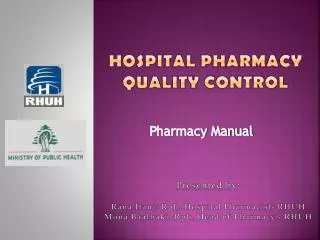
Hospital pharmacy Quality control
Hospital pharmacy Quality control . Pharmacy Manual. Presented by : Rana Itani; Rph, Hospital Pharmacist- RHUH Mona Baalbaki; Rph, Head of Pharmacy - RHUH. The Purpose of the Manual. The pharmacy manual is designed to be a reference for all Hospital staff in order to identify: &
1.92k views • 29 slides

Rob Duncombe Pharmacy Operations Manager Broomfield Hospital.
298 views • 16 slides

Using Hospital Pharmacy Reference Tools in IV Therapy
2. Transition to Hospital Pharmacy. RetailDispensingPrescription order entryOrals, topical, some injectables .Insurance issuesCustomer serviceCompounding?Physician callsInventory management. HospitalDispensing 24 hourDrug FormularyRobotics, Automated Dispensing CabinetsBPCV (Barcod
691 views • 36 slides
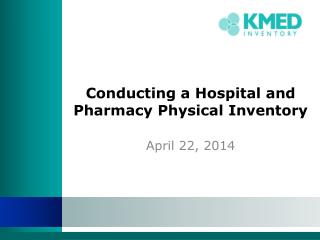
Conducting a Hospital and Pharmacy Physical Inventory
Conducting a Hospital and Pharmacy Physical Inventory. April 22, 2014. Introduction. Kevin Ketels has served as the CEO of KMED LLC since its founding in 2005.
345 views • 0 slides

3 rd Party Partnerships and Hospital Pharmacy Services
Guild of Healthcare Pharmacists Procurement & Distribution Interest Group Thursday 12 November 2009. 3 rd Party Partnerships and Hospital Pharmacy Services. 3rd Party Partnerships and Hospital Pharmacy Services. Tom Gray Chief Pharmacist, Royal Derby Hospital
288 views • 9 slides

Hospital Pharmacy Part -3
Hospital Pharmacy Part -3. Shiekha AlAujan Msc . Purchasing & Inventory Control. Managing the Purchesing & Inventory Control System. The Hospital Formulary System is the cornerstone of purchasing inventory control maintained by P&T committee
1.08k views • 39 slides
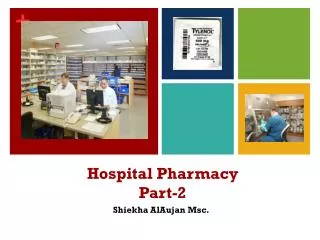
Hospital Pharmacy Part -2
Hospital Pharmacy Part -2. Shiekha AlAujan Msc . Inpatient Pharmacy Services. Inpatient Pharmacy Service. Provides medications for all inpatients on a 24-hour basis. Inspection & control of drugs in all treatment areas. Cooperate with medical drug research. Inpatient Pharmacy Service.
1.29k views • 25 slides

Chapter 15. Hospital Pharmacy
Chapter 15. Hospital Pharmacy. Jeffery D. Evans, Pharm.D . Associate Professor of Pharmacy Practice ULM COP. Chapter 15. Purpose To regulate the practice of hospital pharmacies Impact Significantly clarifies rules for hospitals. Introductions (1501 – 1503).
311 views • 9 slides

Hospital Pharmacy Part-1
Hospital Pharmacy Part-1. Shiekha AlAujan Msc . Hospital Pharmacy . A hospital department responsible for receiving, storing, and distributing medical, pharmaceutical & surgical supplies to: hospitalized patients patients being discharged hospital employees
3.42k views • 38 slides

Adoption of Change in Hospital Pharmacy Practice
Adoption of Change in Hospital Pharmacy Practice . Jean-François Bussières B Pharm MSc MBA FCSHP Chef, département de pharmacie et unité de recherche en pratique pharmaceutique, CHU Sainte-Justine Professeur titulaire de clinique, Faculté de pharmacie, Université de Montréal Kevin Hall
628 views • 43 slides

Clinical Pharmacy Services at a public sector hospital
Clinical Pharmacy Services at a public sector hospital. The Children’s Hospital & Institute of Child Health, Lahore. Zaufishan Rahman. The Children Hospital & Institute of Child Health. State of the art - Tertiary care hospital Centre of Excellence
755 views • 35 slides

The Evolution of Pharmacy at Royal Adelaide Hospital
A/Prof Chris Doecke BPharm PhD FSHP. The Evolution of Pharmacy at Royal Adelaide Hospital. SA Medical Heritage Society. 1. Pharmacy at RAH – Back to the Future. Statewide Clinical Support Services Part of SA Pharmacy since July this year
781 views • 40 slides
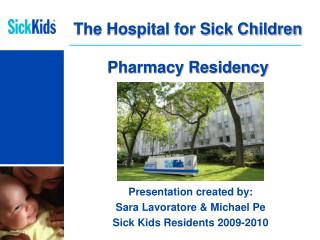

The Hospital for Sick Children Pharmacy Residency
The Hospital for Sick Children Pharmacy Residency. Presentation created by: Sara Lavoratore & Michael Pe Sick Kids Residents 2009-2010. Beverly Hales, BSc Phm, MHSc, RPh Director of Pharmacy.
428 views • 16 slides

hospital pharmacy
hospital pharmacy. Prepared by Nehad Jaser Ahmed. Introduction to hospital pharmacy. A hospital pharmacy is concerned with pharmacy service to all types of hospital and differs considerably from a community pharmacy .
8.93k views • 71 slides

Kelowna General Hospital Renal – Pharmacy Collaboration
hi. Kelowna General Hospital Renal – Pharmacy Collaboration Pharmacist Managed MedRec and Care of End Stage Renal Disease in Patients. Background.
297 views • 13 slides

IHE Pharmacy domain Profiles for Community and Hospital Pharmacy. Jürgen Brandstätter IHE Pharmacy co-chair. Radiology since 1998. Cardiology since 2003. Pathology since 2006. Laboratory since 2003. Eye Care since 2006. (Healthcare) IT Infrastructure since 2003.
524 views • 23 slides
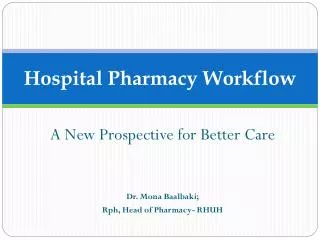
Hospital Pharmacy Workflow
Hospital Pharmacy Workflow. A New Prospective for Better Care Dr. Mona Baalbaki; Rph, Head of Pharmacy- RHUH. RHUH is a University Hospital Serving Various Specialties. Internal Medicine. CCU. ICU. Delivery. Pediatrics. Oncology. Surgery. OBS & GYN.
2.36k views • 39 slides

Hospital pharmacy 2
Hospital pharmacy 2. In patient. HOSPITAL DRUG DISTRIBUTION SYSTEM. newer concepts and ideas in connection with hospital drug distribution systems: Centralized or decentralized (single, or unit-dose) dispending
2.29k views • 39 slides

Hospital Pharmacy Education
Role of a Pharmacists, purchasing, ancillary products,
695 views • 25 slides
An official website of the United States government
Official websites use .gov A .gov website belongs to an official government organization in the United States.
Secure .gov websites use HTTPS A lock ( Lock Locked padlock icon ) or https:// means you've safely connected to the .gov website. Share sensitive information only on official, secure websites.
- Publications
- Account settings
- Advanced Search
- Journal List

An Overview of the Current State and Perspectives of Pharmacy Robot and Medication Dispensing Technology
Asmaa r alahmari, khawlah k alrabghi, ibrahim m dighriri.
- Author information
- Article notes
- Copyright and License information
Asmaa R. Alahmari [email protected]
Corresponding author.
Accepted 2022 Aug 31; Collection date 2022 Aug.
This is an open access article distributed under the terms of the Creative Commons Attribution License, which permits unrestricted use, distribution, and reproduction in any medium, provided the original author and source are credited.
It has been widely reported that a large number of patients die from cases of errors in the issuing of medication prescriptions. These cases occur due to a wide range of things, but the common denominator in all of the cases is humans. A hospital pharmacy has a very critical task, especially with growing patient numbers. The increasing number of prescriptions needed to be filled daily reduces the amount of time that the staff can use to focus on each individual prescription, which may increase the human error ratio. The need for robotic-assisted pharmacies is arising from here to distribute drugs to eradicate or substantially reduce human error. The pharmacy robot is one of the most significant technologies that play a prominent role in the advancement of hospital pharmacy systems. The purpose of this review paper is to cover the pharmacy robot concept and the published literature reporting on pharmacy robot technology as one of the most important applications of artificial intelligence (AI) in pharmacology. Although the outcomes of the impact of the pharmacy robot have been increasingly beneficial in overall improvement, staff morale, and functionality of pharmacies, there are still mechanical errors occurring. The errors, in turn, require human intervention. The key takeaway from this study is that robots or machines cannot replace human duties in their entirety. This in turn means that those human interventions will have an impact on the workflow and throughput.
Keywords: pharmacy robot, pharmacy automation, pharmaceutical, robotics, medication dispensing
Introduction and background
Introduction
The aim of a hospital pharmacy is to provide patients with the prescribed medication when the medication is scheduled according to the professional’s instructions. However, this is not an easy task, especially with growing patient numbers. Although patient safety and care are the ultimate and possibly only priorities, the impact of human error in the process of issuing medication to patients can be, at times, deadly. These errors occur in various ways, such as the incorrect dosage being issued or the medication not being issued at the correct time. Nonetheless, all of these can and do have serious consequences. In addition, this is a major logistical concern as the pharmacy delivers drugs by various dispensing methods and delivery routes to all the hospital units [ 1 , 2 ].
There are many different types of technologies available inside a hospital pharmacy framework that work to enhance patient safety by reducing prescription mistakes and missing drugs. The pharmacy robot is one of the most significant technologies that play a prominent role in the advancement of hospital pharmacy systems [ 1 - 5 ]. The pharmacy robot is almost flawless in medication administration, and the correct algorithm allows the application of the five rights as published in a study [ 6 ]. These rights refer to the only way to avoid errors by ensuring the correct patient received the correct medication and dosage in the correct administration at the correct time.
Using robots ensures a considerable decrease in the time, costs, and production of overall waste in pharmaceutics and other biological research fields [ 2 , 7 ]. The time needed to prepare the prescription is also one of the significant advantages of using robotic technologies [ 7 ]. Besides, robotics reduces the percentage of medication errors [ 8 ].
Even though robots can provide unattended operations for the handling of pharmaceutics, they need the attention of an operator as machine errors still occur, albeit rarely. Thus, a large concern is that artificial intelligence (AI) will displace humans in their duties, and although there are ethical questions when implementing AI in the healthcare sector, it is inevitable that human intervention will continue. These human interventions do, however, affect both the workflow and throughput. Human intervention could take the form of an operator who needs to direct, load, or unload products. Mechanical issues, defined as errors within the system, continue to occur, which then require intervention from an operator. Mechanical errors were recorded as varying problems, such as material problems, which included vials or fluid bags not falling within the weight parameters, misshapen needles, or the inability for the robot to successively grip or hold a vial due to manufacturing defaults in the assembly of the robot. Other errors occurred due to manufacturing changes whereby measurements of syringes or other items were incorrect. Barcode and vial recognition failures were also reported, and this is due to the limitations of the robot's being able to overcome multiple simultaneous versions of a task. All of these errors required the intervention of the pharmacist or technician in order to verify necessary data, adjust parameters, or repair manufactured defaults [ 9 ]. The purpose of this article is to review pharmacy robot technology as one of the most important applications of AI in pharmacy.
What Are Artificial Intelligence and Pharmacology?
In simple terms, AI is the ability of a system, mostly computers, to act intelligently and therefore perform tasks that would normally require human intervention. There are many things that power these systems; they can be simple things like rules, machine learning, or even deep learning [ 10 ]. Pharmacology refers to the chemicals used in the treatment of illness and disease [ 11 ].
What Is a Robot?
According to various sources of literature, a robot is considered an intelligent agent, either virtually or mechanically. This agent can then carry out tasks either under the supervision of guidance, typically via remote control, or automatically. An automaton, which is the common name for an autonomous robot, refers to a robot that can undertake various tasks in environments that are either structured or not. The robot is able to perform these tasks without human supervision. Robotics has seen substantial advances over the past years leading to its increased applications in numerous real-world complications including automated industrial manufacturing, healthcare and medical robots, and self-driving vehicles [ 12 ]. Today’s society has seen the use of these robots across various applications, fields, and sectors. Examples include the transportation, medical, military, and banking sectors, to name a few. Relevant to this study is the use of robots within the pharmaceutical sector; these robots that are usually functioning autonomously can be programmed and configured in order to make the distribution of prescription drugs more effective and efficient, therefore reducing the need for human intervention and, in turn, reducing the risk of human error [ 13 ].
Robots make use of map-making algorithms in order to create a map of their environment. These algorithms allow the robot to have an accurate display of its environment, which is essential for the effectiveness of the application. These maps are used in the same way that humans use maps. The robots use the maps for guidance to “see” their environment. The accuracy of these maps is important as it forms the basis of the practical applications needed to be carried out by the robots [ 13 ].
As with all technology, the aim of this kind of technology is to ensure effective, efficient, and accurate application within the setting. This in turn means that the pharmacy robot will be able to take the art of traditional medical dispensing into the next era. The benefits of this particular application include increased productivity; a medical dispensing fault-free environment; pharmaceutical operations that are effective, safe, and secure; shortened patient "waiting period," and a germ-free and safe environment [ 14 ].
Pharmacy Robot's System Architecture
For efficiency, the best fit across multiple areas is usually custom. From the view of the system architecture, each application, robot, or system is custom designed and built based on the needs and functions of the system. All aspects involved within the application are carefully considered when an automation system is built. In this section, in order to understand the system architecture, we will explain in detail the pharmacy robot system architecture by giving an example of a pharmacy robot that was introduced by some authors [ 13 ]. As we see in Figure 1 , the robot communicates autonomously and directly with a physician, assistant, or intermediary. The robot then scans the inventory of stock in order to assess the availability of the prescribed medication. When the prescribed medication is available, the robot will fill the container with the medication and store the filled container. This is all done by the robot referencing and interacting with its environment using the internal map created with the map-making algorithm. The specific robot in this article makes use of simultaneous localization and mapping (SLAM). When the patient or representative arrives to collect the prescription, the robot will validate the identity of the individual receiving it. The patient or representative then presents the prescription, and the robot will then issue the prepared medication over to the patient. As mentioned above, this specific robot makes use of AI and SLAM in order to interact with a variety of things. Not only does SLAM allow the robot to have a clear and accurate map of its surroundings, but it also allows the robot to update the map when needed, keeping an accurate and updated “vision” of the current locations of inventory [ 13 ].
Figure 1. General robot interactions.
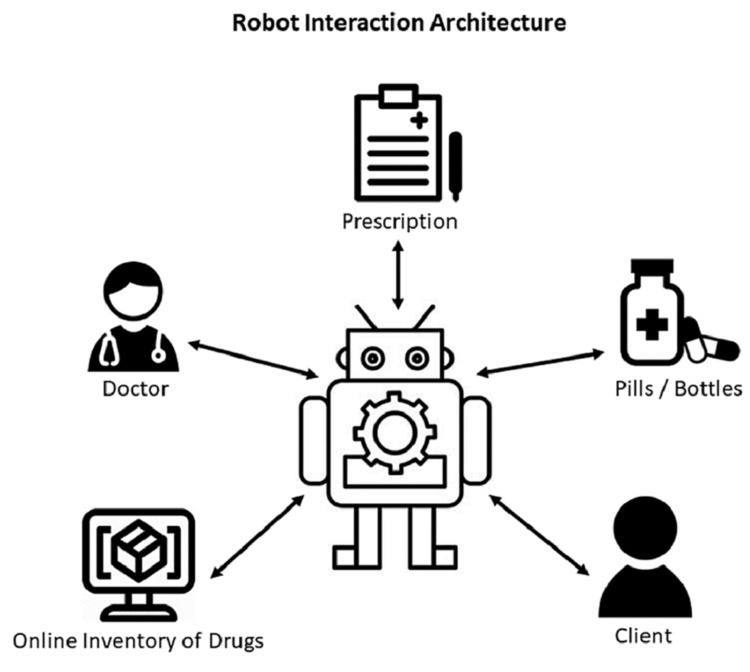
Figure 2 illustrates the physical architecture of the pharmacy area; this is often referred to as an embodiment. Multiple customers may enter and choose an available room. These rooms are individually secure as they can be locked from within [ 13 ]. Over and above this, the vault, which is the store for a variety of medications and dispensers, can be controlled according to specific requirements, such as light and temperature. This allows for the control and reduction of the deterioration of various medicines that require refrigeration, etc. This setup allows the servicing of multiple people at one time [ 13 ].
Figure 2. Architecture of the pharmacy area.
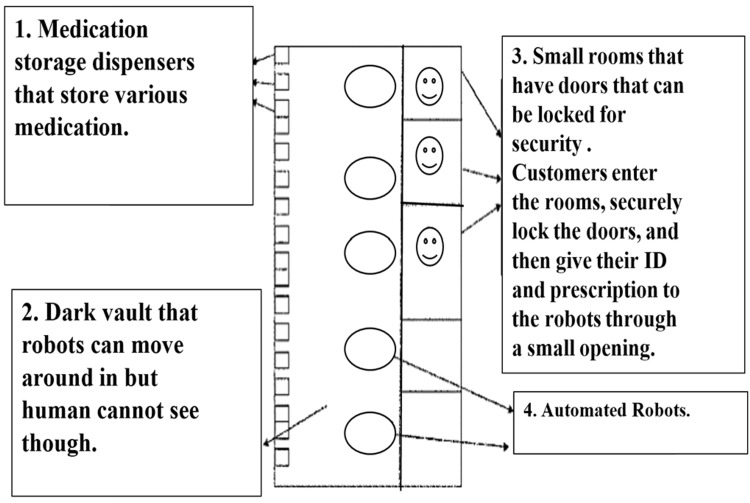
Figure 3 is to clarify the interactions between the robot and medical staff such as doctors or assistants like nurses [ 13 ]. The patient is consulted and examined by a doctor. The patient is then issued a prescription from the doctor. This prescription will contain an authentication mark (barcode, signature, etc.) [ 13 ].
Figure 3. Robot's interactions with medical professionals.
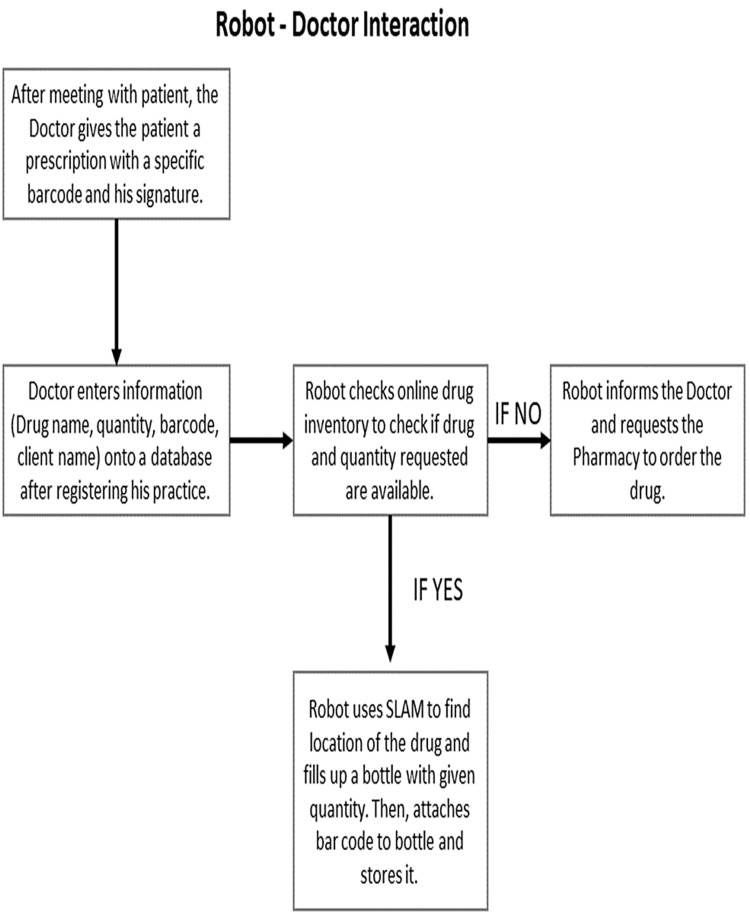
Figure 4 clarifies the interactions between the robot and clients or patients [ 13 ]. If the prescribed medication is in stock, the robot authenticates the prescription by accessing the patient’s file on the network [ 13 ].
Figure 4. Robot's interactions with clients.
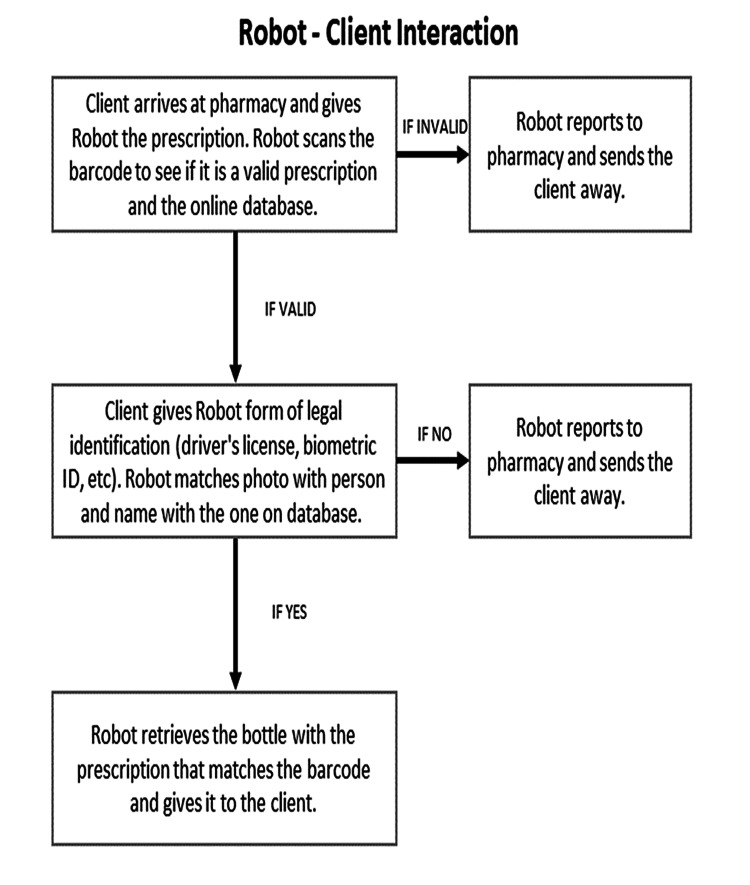
The retrieval and storage of functions of the robot could be as follows in the sequence as shown in Figure 5 [ 13 ].
Figure 5. Architecture of retrieval and storage by the robot.
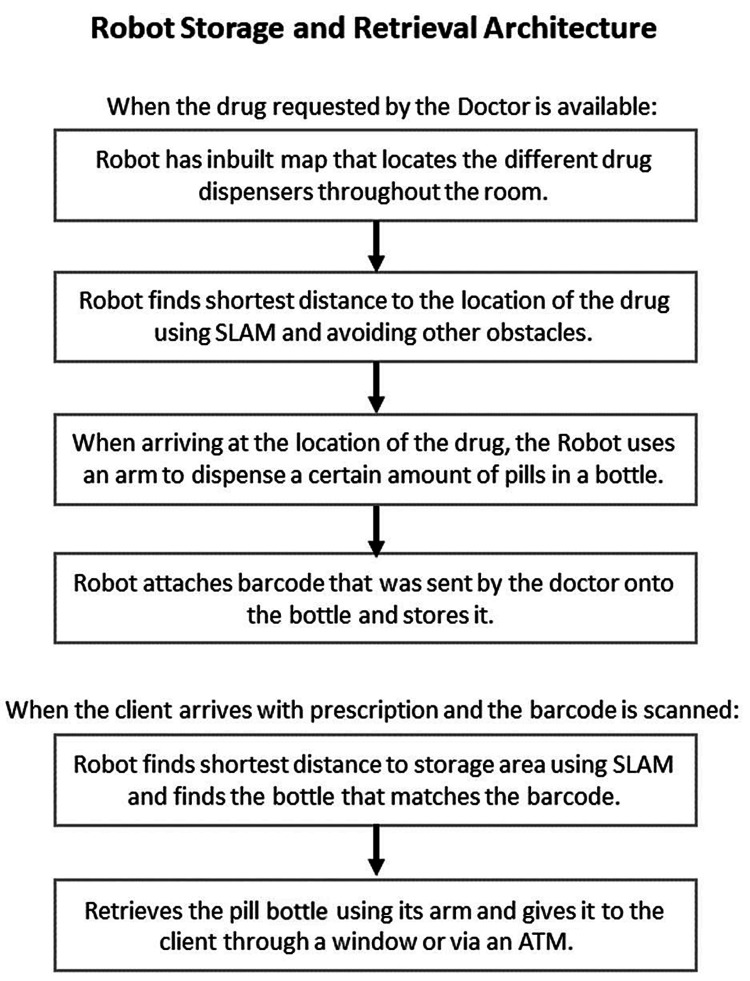
Patients are verified and validated using their biometrics on file. Once complete, the patients can access their medication as shown in Figure 6 [ 13 ].
Figure 6. Robot security architecture and biometric identification.
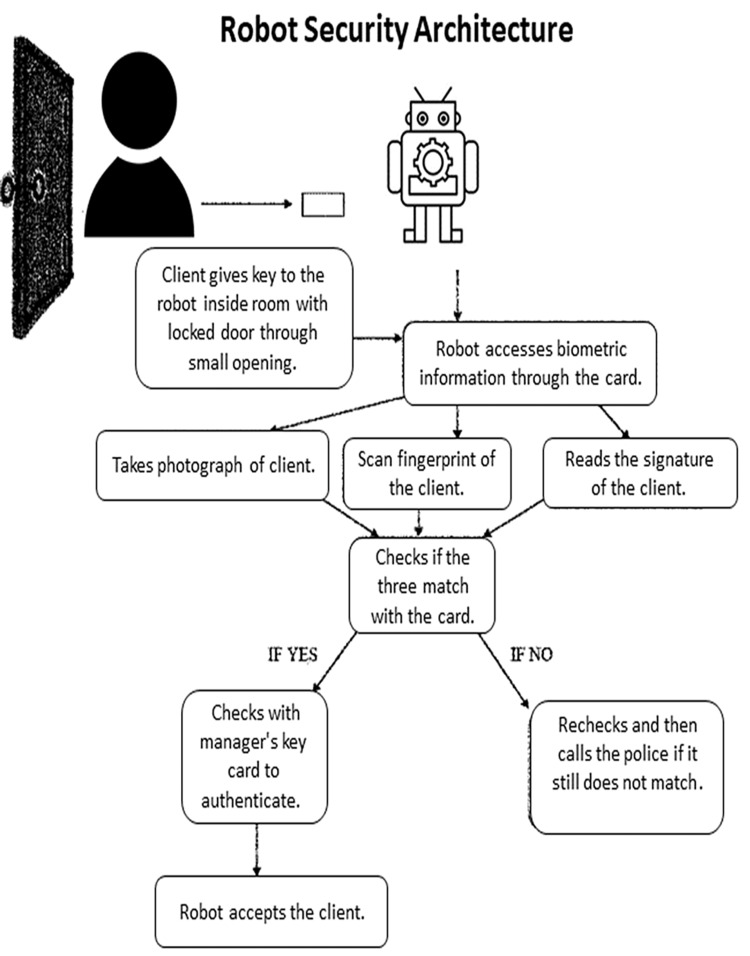
The objective of the current review paper is to cover the published literature reporting on pharmacy robot technology as one of the most important applications of AI in pharmacology. The exploratory search process covered the most relevant organizations in the pharmacology community. The search was conducted using the IEEE Computer Society Digital Library, Association for Computing Machinery (ACM) Digital Library, ScienceDirect, SpringerLink, and Google Scholar. These search engines cover the majority of published pharmacology studies as of April 20, 2020. These search results were screened and filtered to include studies of any design, which reported an outcome measure of interest that was related to the technology of the robot pharmacy. Publications in English that were published in 2010 to date were included. The title, abstract, and full publications were used to identify citations of interest. Once the full review of the publications was completed, several eligible publications were selected for inclusion in our review.
Why a pharmacy robot?
According to www.youhaverights.com , in the United States, it is estimated that 30 million pharmacy errors occur annually. An estimated 7,000 patients die from these cases of errors and thousands of severe complications each year. These errors occur due to the misinterpretation of the prescription by the pharmacist with regard to medication name or dosage, to name a few. The reasons for the occurrence of these errors usually seem to stem from the overworked pharmacy employees. These employees operate under extreme pressure and have ever-increasing workloads. The increasing number of prescriptions needed to be filled daily reduces the amount of time that the staff can use to focus on each individual prescription. The most common pharmacy errors are incorrect dispensing of medications, incorrect dosage being administered due to the failure of staff to instruct consumers on specific medication usage, and incorrect delivery and preparation of IV (intravenous) drugs to patients in hospitals [ 15 ].
So, the need for robotic-assisted pharmacies arises from here to distribute drugs to eradicate or substantially reduce human error. The advantages of robotics in pharmacy are to improve and add to the current patient care and therefore increase revenue, improvement in the overall functionality and operation of pharmacies, and effective management and storage of medication as well as patient data. Overall enhanced productivity leads to increased dispensing speed and, therefore, decreased patient waiting time. It allows for the decentralizing of pharmacy services and the evolution of ward-based medicine management. This allows the elimination or significant decrease in the number of errors and contamination. Therefore, using barcoding and photo verification increases patient safety and decreases the risk of litigation. This improves dispensing efficiency and enables the re-engineering of pharmaceutical services, which leads to maximum utilization of space in hospital pharmacy departments [ 16 - 18 ]. The use of AI is an improvement of the traditional pharmaceutical dispensing system. Although we have seen the evident improvement and efficiency that technology adds to various systems, such as the reduction or absence of human error, as with anything that is not perfect and has been created by man, it would be unwise to not take into account the disadvantages that technology presents. These disadvantages include the following: computer literacy and staff competencies may impact their ability to manage or program the dispensing robot. This could lead to extensive input of training over a significant period of time. The dispensing robot requires accurate programming as incorrect programming may lead to errors. As with most technology, there are sizable startup costs, maintenance costs as well as the need for continuous software updates. It is well known that with the evolution of technology, systems can be considered out of date quite quickly, which will then require updating. Although robots will bring increased and improved efficiency and productivity, the redundancy of pharmacists will never occur. Where there is a limited pharmacist and patient interaction, it might make patients reluctant to use the service. These dispensing robots rely on computer programs that can fail at any time. The maintenance and upgrade of software as well as the connection of the dispensing robot to the pharmacy’s system could be timely and will require meticulous detail in order to avoid any repercussions and errors.
Examples of pharmacy robot
The following are some of the most widely known unit dose drug automation systems in the world. These are Pyxis and Rowa Speedcase automation systems. Their advantages and disadvantages can be summarized as follows in Table 1 [ 1 , 19 , 20 ].
Table 1. Some examples of pharmacy robots.
A comparison between robot pharmacies and traditional pharmacies
Pharmacy robots are mechanical devices that conduct planned, sophisticated, and repetitive manipulations that mimic human behavior without continual input from a human. As part of their treatment, the majority of patients require medication. Various technology-based solutions, such as computerized physician order entry (CPOE) and patient barcoding (BC) systems, have been implemented in hospitals to increase patient safety. According to current evidence, documenting, dispensing, and giving drugs to patients are all high-risk steps in taking medicine [ 21 ].
Automated methods have been introduced in many pharmaceutical distribution systems to address the risks of manual dispensing and administration systems. In addition, there is a lot of pressure to cut expenditures and reallocate time from manual distribution. Putting these resources toward greater clinical work has been a success. New methods and procedures must be developed to reduce patient wait times, provide drug therapy information to physicians and pharmacists, and increase productivity by automating administrative tasks [ 22 ].
van Doormaal et al. reported that manual medication evaluation revealed 57 pharmaceutical overdose errors and 143 therapeutic errors, 46 of which were drug-drug interactions. A total of 297 safety alerts regarding overdose and 365 safety alerts involving drug-drug interactions were generated using CPOE and basic clinical decision support systems. The clinical rules yielded 313 safety alerts, accounting for 39% of all overdoses and treatment mistakes discovered in the manual assessment. The patients in 23% of the warnings generated by a clinical rule required a medication adjustment, as indicated by the manual evaluation [ 23 ].
Amodeo et al. reported that the median error detected during reconstitution, dilution, and final therapy of medications made by the I.V. Station® was less than 5%, with narrower error ranges than drugs prepared manually. Unlike the manual technique, the I.V. Station® consumed fewer materials, lowered expenses, cut preparation time, and streamlined the medicine process as the number of preparations increased [ 24 ]. Table 2 shows a comparison between robot pharmacies and traditional pharmacies.
Table 2. A comparison between robot pharmacies and traditional pharmacies.
Obstacle avoidance by hospital ward inspection robots in a complex environment
Laser radars, vision modules, ultrasonic radars, and infrared radars are the principal sensors used to identify obstructions. There are two types of laser radar: 2D and 3D laser radars. Because of the narrow detection range of infrared radars, they have little value for warning ahead of time. Similarly, ultrasonic radars have little use for warning ahead of time due to ultrasonic reflection and poor orientation performance [ 38 ].
Detection of Obstacles
With the laser sensor carried on its own body, the robot identifies dynamic and static impediments and establishes the laser sensor's detection model. Using a multilayer perception strategy based on the potential field exclusion approach, the robot judges the obstacle's perception layer in terms of different distances between the robot and the obstruction and then pushes itself to execute different mobility strategies. The design of the threshold value between each layer is dependent on the robot's running speed, deceleration, acceleration, the current electric amount of power, and the corridor's size [ 39 , 40 ].
Conclusions
AI applications have left visible marks in many different fields. With robots, hospital pharmacies will increase their performance, increase prescription filling levels, improve counting accuracy, minimize drug errors, increase safety, ensure adherence to patient doses, automate their supply chains, and avoid delays in supplies and stock outages. Besides, robots can also help them minimize costs as they do not need to hire additional staff to support the extra load at peak times. The advantages are apparent, but what this means for humans and their sustainability is a concern. If robots are able to perform better, there will be no need for humans, and large-scale unemployment could occur. The famous late Stephen Hawking said, “This may mean the end of the human race." It would therefore be essential to create AI to work with humans rather than independently. AI can ensure accuracy within the parameters of the task, and humans will be able to have a broader reach when making decisions. Clinical decisions can be improved with AI and thus drive further research. The important goals of our future research will be to cover more studies related to pharmacy robots and medication dispensing technologies. We are also interested in comparing the studies with analysis and critical evaluation. It would be interesting to see how smart hospitals embrace this growing trend in the future.
The content published in Cureus is the result of clinical experience and/or research by independent individuals or organizations. Cureus is not responsible for the scientific accuracy or reliability of data or conclusions published herein. All content published within Cureus is intended only for educational, research and reference purposes. Additionally, articles published within Cureus should not be deemed a suitable substitute for the advice of a qualified health care professional. Do not disregard or avoid professional medical advice due to content published within Cureus.
The authors have declared that no competing interests exist.
- 1. Goundrey-Smith S. Information Technology in Pharmacy. London: Springer; 2013. Pharmacy automation; pp. 95–119. [ Google Scholar ]
- 2. Standardizing pharmaceutical delivery to reduce pharmacy costs while simultaneously reducing missing doses. Svirsko AC, Norman BA, Hostetler S. IISE Trans Healthc Syst Eng. 2020;10:33–46. [ Google Scholar ]
- 3. Reducing pharmacy patient waiting time. Alam S, Osama M, Iqbal F, Sawar I. Int J Health Care Qual Assur. 2018;31:834–844. doi: 10.1108/IJHCQA-08-2017-0144. [ DOI ] [ PubMed ] [ Google Scholar ]
- 4. Effect of an automated dispensing system on errors in two pharmacies. Flynn EA, Barker KN. J Am Pharm Assoc (2003) 2006;46:613–615. doi: 10.1331/1544-3191.46.5.613.flynn. [ DOI ] [ PubMed ] [ Google Scholar ]
- 5. Impact of community pharmacy automation on workflow, workload, and patient interaction. Angelo LB, Christensen DB, Ferreri SP. J Am Pharm Assoc. 2005;45:138–144. doi: 10.1331/1544345053623537. [ DOI ] [ PubMed ] [ Google Scholar ]
- 6. The five rights: a destination without a map | institute for safe medication practices. [ Jun; 2022 ]. 2007. https://www.ismp.org/resources/five-rights-destination-without-map https://www.ismp.org/resources/five-rights-destination-without-map
- 7. Effect of a robotic prescription-filling system on pharmacy staff activities and prescription-filling time. Lin AC, Huang YC, Punches G, Chen Y. Am J Health Syst Pharm. 2007;64:1832–1839. doi: 10.2146/ajhp060561. [ DOI ] [ PubMed ] [ Google Scholar ]
- 8. Watch robots transform a CA hospital. [ Jun; 2022 ]. 2015. https://www.npr.org/sections/money/2015/05/27/407737439/watch-robots-transform-a-california-hospital https://www.npr.org/sections/money/2015/05/27/407737439/watch-robots-transform-a-california-hospital
- 9. Implementation of an i.v.-compounding robot in a hospital-based cancer center pharmacy. Yaniv AW, Knoer SJ. Am J Health Syst Pharm. 2013;70:2030–2037. doi: 10.2146/ajhp120649. [ DOI ] [ PubMed ] [ Google Scholar ]
- 10. Sabharwal A, Selman B. Elsevier. Vol. 175. Elsevier ; 2011. S. Russell, P. Norvig, artificial intelligence: a modern approach, third edition; pp. 935–937. [ Google Scholar ]
- 11. Kenakin TP. Elsevier. Amsterdam, Netherlands: Elsevier; 2019. A Pharmacology Primer: Techniques for More Effective and Strategic Drug Discovery, Fifth Edition. [ Google Scholar ]
- 12. Autonomy for surgical robots: concepts and paradigms. Haidegger T. IEEE Transactions on Medical Robotics and Bionics. 2019;1:65–76. [ Google Scholar ]
- 13. Pharmacy automation using autonomous robot. [ Jun; 2022 ]. 2019. https://patents.justia.com/patent/11200979 https://patents.justia.com/patent/11200979
- 14. Dispensing error rate after implementation of an automated pharmacy carousel system. Oswald S, Caldwell R. http://10.2146/ajhp060313 . Am J Health Syst Pharm. 2007;64:1427–1431. doi: 10.2146/ajhp060313. [ DOI ] [ PubMed ] [ Google Scholar ]
- 15. Applied mathematics for pharmaceutical problems using robotics as assistive tools for learning: a comprehensive review. Singhai M, Singhai AK, Verma K. http://journal.ummat.ac.id/index.php/jtam/article/view/4720 Jurnal Teori dan Aplikasi Matematika. 2021;5:374–391. [ Google Scholar ]
- 16. Pharmacy robotic dispensing and planogram analysis using association rule mining with prescription data. Khader N, Lashier A, Yoon SW. Expert Syst Appl. 2016;57:296–310. [ Google Scholar ]
- 17. Role of the pharmacist in reducing healthcare costs: current insights. Dalton K, Byrne S. Integr Pharm Res Pract. 2017;6:37–46. doi: 10.2147/IPRP.S108047. [ DOI ] [ PMC free article ] [ PubMed ] [ Google Scholar ]
- 18. Health care robotics: qualitative exploration of key challenges and future directions. Cresswell K, Cunningham-Burley S, Sheikh A. J Med Internet Res. 2018;20:0. doi: 10.2196/10410. [ DOI ] [ PMC free article ] [ PubMed ] [ Google Scholar ]
- 19. Pyxis MedStation™ ES System. [ Jun; 2022 ]. 2022. https://www.bd.com/en-uk/products/medication-management/point-of-care/pyxis-medstation-es-system https://www.bd.com/en-uk/products/medication-management/point-of-care/pyxis-medstation-es-system
- 20. A general evaluation on drug distribution and automation systems in pharmacy. Kiran B, Sencan N. https://www.researchgate.net/profile/Metin-Turan-2/publication/336414245_Sentiment_Analysis_of_Tweets_Using_Machine_Learning_2019_Turkey_Van_pages_85-87/links/5da066e0a6fdcc8fc347436a/Sentiment-Analysis-of-Tweets-Using-Machine-Learning-2019-Turkey-Van-pages-85-87.pdf#page=288 International Conference on Data Science. 2019:288–311. [ Google Scholar ]
- 21. Critical evaluation of pharmacy automation and robotic systems: a call to action. Boyd AM, Chaffee BW. Hosp Pharm. 2019;54:4–11. doi: 10.1177/0018578718786942. [ DOI ] [ PMC free article ] [ PubMed ] [ Google Scholar ]
- 22. Outpatient pharmacy automation. Hynniman CE, Lamy PP. Am J Heal Pharm. 1967;24:18–21. [ PubMed ] [ Google Scholar ]
- 23. Comparison of methods for identifying patients at risk of medication-related harm. van Doormaal JE, Rommers MK, Kosterink JG, Teepe-Twiss IM, Haaijer-Ruskamp FM, Mol PG. Qual Saf Health Care. 2010;19:0. doi: 10.1136/qshc.2009.033324. [ DOI ] [ PubMed ] [ Google Scholar ]
- 24. Robotic therapy: cost, accuracy, and times. New challenges in the neonatal intensive care unit. Amodeo I, Pesenti N, Raffaeli G, et al. Front Pharmacol. 2019;10:1431. doi: 10.3389/fphar.2019.01431. [ DOI ] [ PMC free article ] [ PubMed ] [ Google Scholar ]
- 25. Medication errors in inpatient pharmacy operations and technologies for improvement. Kuiper SA, McCreadie SR, Mitchell JF, Stevenson JG. Am J Health Syst Pharm. 2007;64:955–959. doi: 10.2146/ajhp060267. [ DOI ] [ PubMed ] [ Google Scholar ]
- 26. Process performance of a new liquid medication dispensing robot [IN PRESS] Lagrange FJ, Lagrange JV. Eur J Hosp Pharm. 2021 doi: 10.1136/ejhpharm-2021-002811. [ DOI ] [ PMC free article ] [ PubMed ] [ Google Scholar ]
- 27. Increasing pharmacy productivity and reducing medication turnaround times in an Italian comprehensive cancer center by implementing robotic chemotherapy drugs compounding. Capilli M, Enrico F, Federici M, Comandone T. J Oncol Pharm Pract. 2022;28:353–361. doi: 10.1177/1078155221992851. [ DOI ] [ PubMed ] [ Google Scholar ]
- 28. Impact of robotic antineoplastic preparation on safety, workflow, and costs. Seger AC, Churchill WW, Keohane CA, et al. J Oncol Pract. 2012;8:344-9, 1 p following 349. doi: 10.1200/JOP.2012.000600. [ DOI ] [ PMC free article ] [ PubMed ] [ Google Scholar ]
- 29. Approaches to outpatient pharmacy automation: a systematic review. Sng Y, Ong CK, Lai YF. Eur J Hosp Pharm. 2019;26:157–162. doi: 10.1136/ejhpharm-2017-001424. [ DOI ] [ PMC free article ] [ PubMed ] [ Google Scholar ]
- 30. Robotic pharmacy implementation and outcomes in Saudi Arabia: a 21-month usability study. Momattin H, Arafa S, Momattin S, Rahal R, Waterson J. JMIR Hum Factors. 2021;8:0. doi: 10.2196/28381. [ DOI ] [ PMC free article ] [ PubMed ] [ Google Scholar ]
- 31. Role of pharmacist counseling in pharmacotherapy quality improvement. Sanii Y, Torkamandi H, Gholami K, Hadavand N, Javadi M. J Res Pharm Pract. 2016;5:132–137. doi: 10.4103/2279-042X.179580. [ DOI ] [ PMC free article ] [ PubMed ] [ Google Scholar ]
- 32. Functional health literacy and medication use: the pharmacist's role. Youmans SL, Schillinger D. Ann Pharmacother. 2003;37:1726–1729. doi: 10.1345/aph.1D070. [ DOI ] [ PubMed ] [ Google Scholar ]
- 33. A national survey exploring oral healthcare service provision across Australian community pharmacies. Freeman CR, Abdullah N, Ford PJ, Taing MW. BMJ Open. 2017;7:0. doi: 10.1136/bmjopen-2017-017940. [ DOI ] [ PMC free article ] [ PubMed ] [ Google Scholar ]
- 34. A study of unprevented dispensing incidents in Welsh NHS hospitals. James KL, Barlow D, Burfield R, Hiom S, Roberts D, Whittlesea C. Int J Pharm Pract. 2010;16:175–188. doi: 10.1111/j.2042-7174.2010.00071.x. [ DOI ] [ PubMed ] [ Google Scholar ]
- 35. Unprevented or prevented dispensing incidents: which outcome to use in dispensing error research? James KL, Barlow D, Burfield R, Hiom S, Roberts D, Whittlesea C. Int J Pharm Pract. 2011;19:36–50. doi: 10.1111/j.2042-7174.2010.00071.x. [ DOI ] [ PubMed ] [ Google Scholar ]
- 36. Linked pharmacist-provider new patient visits in primary care. Bateman MT Jr, McCarthy C, Alli K. Am J Manag Care. 2020;26:0–5. doi: 10.37765/ajmc.2020.43159. [ DOI ] [ PubMed ] [ Google Scholar ]
- 37. Effect of electronic prescribing strategies on medication error and harm in hospital: a systematic review and meta-analysis. Roumeliotis N, Sniderman J, Adams-Webber T, et al. J Gen Intern Med. 2019;34:2210–2223. doi: 10.1007/s11606-019-05236-8. [ DOI ] [ PMC free article ] [ PubMed ] [ Google Scholar ]
- 38. Machine vision based sliding fuzzy-PDC control for obstacle avoidance and object recognition of service robot platform. Mon Y-J. J Intell Fuzzy Syst. 2015;28:1119–1126. [ Google Scholar ]
- 39. Dynamic obstacle avoidance of vision sensor mobile robot based on prior knowledge. Cu W, Zhang P. IEEE. 2020:729–735. [ Google Scholar ]
- 40. Obstacle avoiding strategy of mobile robot via binocular stereovision. Fuzhong W, Haibo L, Fashan Y. IEEE. 2008:457. [ Google Scholar ]
- View on publisher site
- PDF (1.1 MB)
- Collections
Similar articles
Cited by other articles, links to ncbi databases.
- Download .nbib .nbib
- Format: AMA APA MLA NLM
Add to Collections

IMAGES
VIDEO